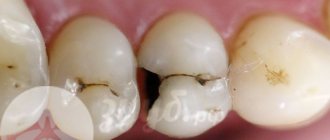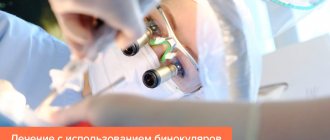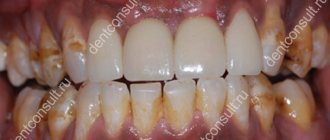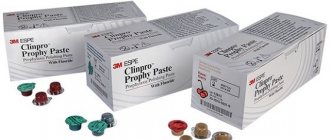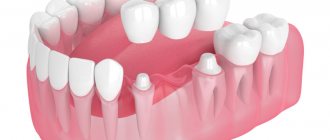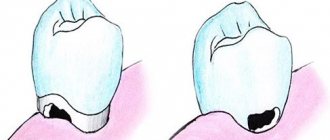Caries is treated using various methods depending on the stage of its development and the degree of damage to the tooth. At the initial stage, doctors use solutions to remineralize the enamel. The procedures are carried out in the clinic. For home use, special anti-caries remedies are prescribed: pastes, gels and rinses. Let's find out what makes them special.
In this article
- What is caries and why does it occur?
- Risk factors for dental caries
- Stages of caries
- Why should a dentist prescribe anti-caries medications?
- What remedies are there for caries?
- Tooth pastes against caries
- The best toothpastes for caries
- Gels for caries
- Anti-caries rinses
- Anti-caries preparations for internal use
- Other caries prevention measures
Treatment methods for caries are determined by the stage of the disease. You should also understand the nature of the pathology in order to choose the right remedy. However, it is immediately worth noting that it is impossible to cure carious lesions with tablets and toothpastes. Treatment is carried out by a dentist. If necessary, he will prescribe appropriate medications that can be used at home.
What is caries and why does it occur?
Caries is a pathological process that destroys the hard tissues of the tooth. The main reason for its development is the proliferation of cariogenic microorganisms from the Streptococcus mutans group in the oral cavity. Their waste products - acids - corrode tooth enamel, as a result of which there are fewer minerals in it that ensure its strength. It softens and exposes the hard tissues of the tooth. Further spread of bacteria leads to the destruction of dentin and damage to nerve endings.
Caries is a progressive pathology that does not go away on its own. If left untreated, you can lose a tooth or develop inflammatory diseases of the soft and hard tissues of the oral cavity - pulpitis, periodontitis, etc.
It is not always necessary to fill teeth. In the initial stages, it is possible to restore enamel using therapeutic methods. We will talk about the factors in the development of caries, after which we will describe the means used to treat it.
Risk factors for dental caries
Cariogenic microbes are present in the oral cavity of almost every person. But they become dangerous only if conditions are favorable for them. They are also called caries development factors and can be local or general. Among the first:
- Tartar. Poor oral hygiene leads to the formation of plaque on teeth. Over time, it hardens and turns into tartar. In it and under it there are many bacteria that easily destroy the enamel and penetrate the hard tissues of the tooth.
- Insufficient saliva production. Together with saliva, food debris and germs are washed out of the mouth. In addition, it contains substances that neutralize acids produced by bacteria. If the salivary glands are not working well, microorganisms multiply faster, which increases the risk of developing caries.
- Anatomical features of the jaw. Incorrect bite or tooth growth causes food debris to accumulate in the interdental spaces. Because of this, the number of microbes in the mouth increases.
- Poor nutrition. People who eat a lot of sweets are more likely to suffer from tooth decay. This is due to the fact that cariogenic microbes feed on carbohydrates.
Also, the likelihood of carious lesions increases with cardiovascular and endocrine diseases, problems with the gastrointestinal tract and weak immunity.
During treatment, it is important to eliminate as many factors as possible that cause bacteria to multiply. Various anti-caries remedies help cope with this. Let us describe the stages of development of the pathology, on the basis of which the method of its elimination is determined.
How to treat caries using traditional methods
Of course, it will not be possible to cure even average caries using traditional methods; you can only temporarily relieve the pain while you wait for an appointment with a doctor.
For this you can use:
- saline mouth rinse;
- camphor alcohol - by moistening a cotton swab with it, you can wipe not only the sore tooth, but also the gum near it;
- fir oil - a swab moistened with it should be placed on the tooth and adjacent gum and held for half an hour;
- alcohol infusion of horseradish - grate the horseradish, pour in vodka, leave for a couple of days, strain and apply a swab moistened with it to the sore tooth for ten minutes;
- infusion of onion peels - take a few spoons of onion peels, pour boiling water, leave for 24 hours, strain and rinse the mouth several times a day;
- garlic juice - get garlic juice using a blender or a garlic press, moisten a tampon in it and apply it to the tooth for 10-15 minutes.
You can also use traditional methods to treat caries in the initial stage - the spot stage. Here they will come to the rescue:
- sage decoction: you can rinse your mouth with the prepared solution almost an unlimited number of times;
- infusion of raspberry and mint leaves: leave the chopped leaves in wine vinegar for three days, strain and rinse your mouth with the resulting infusion;
- chicory root: fresh root can be chewed, and dried, pour water, leave and rinse your mouth;
- laundry soap: prepare a solution of soap and water and rinse your mouth with it;
- propolis: place a piece of propolis on a sore tooth, press with a cotton swab and leave for a while.
Stages of caries
There are 4 stages of caries, each of which has its own specific characteristics. During diagnosis, it is important to determine the extent of tooth damage in order to correctly prescribe treatment. Caries begins with the stage of a white (chalky) spot, which is an area of demineralization of tooth enamel. It loses its shine and looks slightly different from the rest of the tooth. However, only a doctor can reveal this during an examination.
The danger of the first stage is that the person does not feel any changes: his tooth does not hurt, his gums do not bleed, and there is no discomfort when chewing food. In fact, it is usually possible to detect caries at this stage only during a preventive examination, for which every person should come to the dentist once every six months. Otherwise, the carious process continues to progress.
At the second stage, the white spot darkens, acquires a brown or yellow tint and becomes noticeable if it is not localized on the inside of the teeth or between them. The first subjective signs of the disease also appear: discomfort is felt after eating sweet foods. The tooth becomes more sensitive, but this symptom disappears as soon as you rinse your mouth or brush your teeth. The carious cavity has not yet formed; the pathological process spreads along the enamel, but does not affect hard tissues.
In the first two stages, the disease can still be cured with therapeutic methods using anti-caries agents: solutions, pastes and gels. If a person ignores the symptoms, a carious cavity forms, indicating the beginning of the third stage. The tooth becomes more sensitive to sweet and sour foods, low and high temperatures, toothpaste and water. The pain subsides after the irritant is removed.
At the third stage, a hole is formed in which bacteria actively multiply. They penetrate the dentin, as a result of which the hard tissues of the tooth begin to deteriorate. At this stage, you cannot do without preparation and installation of a filling. Lack of treatment leads to the development of the fourth stage of caries, which is considered an advanced form of pathology.
Deep carious lesions cover at least ⅓ of the tooth. A brown cone-shaped cavity is formed. It is separated from the pulp by a thin partition of hard tissue. There is a risk of developing pulpitis - inflammation of soft tissues. In such cases, it is often necessary to remove the nerve. There is a high risk of tooth loss. At any moment it can split into several parts or break in the neck area if the carious process is localized near the gums.
Complications of caries
Most often, the cause of complications with dental caries is the person himself, however, improper treatment can lead to unpleasant consequences (which is why choosing a dental clinic is so important). The development of untreated dental caries leads to negative changes in the structure of dentin, it becomes infected, the pulp becomes inflamed (the disease is called “pulpitis”), which is accompanied by acute pain. However, pain occurs not only with inflammation of the pulp, but also with deep caries, since the pulp chamber is covered only by a thin layer of affected tissue, which cannot protect against mechanical pressure on the neurovascular bundle during meals.
Teeth can also hurt in the middle stage: the nerve endings in the area of the enamel-dentin line react to external influences, causing pain.
Deep infection often leads to complications. In some cases, phlegmons and abscesses develop, which pose a significant threat to the general condition of the patient, and sometimes even to his life. the body has to devote all its strength to fighting the source of infection, the immune system is weakened, which can lead to the occurrence of systemic diseases. In such situations, it is often necessary to resort to surgery to get rid of the purulent contents and prevent the infection from spreading further.
Why should a dentist prescribe anti-caries medications?
Medicines for caries are prescribed by a doctor. Treatment begins with procedures in the clinic. The dentist applies a special composition to the patient’s tooth affected by caries, which contains various minerals: fluoride, calcium, magnesium, etc. Several procedures may be required. Before they are carried out, ultrasonic cleaning is performed. It is necessary to clean the carious lesion from bacteria so that they do not interfere with the restoration of the enamel.
Only after this the doctor prescribes anti-caries medications that enhance the effect of the composition applied to the tooth. It should be understood that they do not cure, but prevent the further spread of pathology. In other words, they are means of prevention.
Treatment of caries in children under 3 years of age
The method of treating caries in children under 3 years of age depends on the stage of the disease, the individual characteristics of the child and, of course, his attitude towards dentists.
- At the stain stage, the doctor removes plaque and remineralizes the enamel using solutions or silvers the teeth.
- Superficial, medium and deep caries in children 1-3 years old (and older) are treated using a drill. If necessary, the doctor uses anesthesia. If a child suffers from aching toothache, canal depulpation is performed.
Remineralization
Remineralization is the restoration of damaged tooth enamel. To carry it out, the doctor cleans the surface of the affected area, and then covers the rows with a special composition with fluorine and calcium. The procedure is absolutely painless, most children tolerate it easily.
To avoid the development of caries in children, dentists recommend repeating remineralization every six months.
Silvering
This method enhances the protective abilities of enamel and is recommended for children who are afraid of dentists. The surface of the teeth is coated with silver nitrate. The substance provides a reliable antiseptic effect, but parents should be mentally prepared that after treatment the child’s teeth will turn black.
Sealing
For children over 1 year old, the dentist can fill damaged teeth. This treatment does not necessarily require the use of a drill. If the caries is shallow, the doctor applies a special solution with acid to the tooth. The substance corrodes the affected tooth surface, disinfects the carious cavity and applies photopolymer material.
If a child comes to the doctor with deep caries, it will not be possible to do without drilling. Before starting treatment, the doctor gives the baby anesthesia, since baby teeth have nerve endings.
Treatment of caries in children 2-3 years of age and older can be supplemented with procedures such as
- preparation or opening of a cleaned carious cavity;
- depophoresis – introduction of an electric current of copper-calcium hydroxide ions;
- ozone therapy - treatment of carious cavities using a jet of ozone gas;
- photodynamic therapy – application of a special medicinal paste to a carious tooth and subsequent laser treatment of the area.
Tooth pastes against caries
There is no separate class called “anti-caries toothpastes.” However, some of them contain fluorides, which help restore enamel. When buying pasta, pay attention to the composition. It must contain at least 1000 ppm fluoride. If it is contained in a volume of 1450 ppm, the paste can be considered therapeutic and prophylactic. In the dentist's office, a tooth affected by caries is treated with a mixture with a fluoride concentration of 5000 ppm.
The following elements may also be present in the anti-caries paste:
- Calcium: Helps normalize mineral balance.
- Chlorhexidine and other antiseptics: indicated for patients with irregular oral hygiene.
- Abrasives: remove plaque from enamel. Instead, the paste may contain hydrogen peroxide. However, such compositions are contraindicated for deep caries. Moreover, they cannot be used continuously. The duration of use is determined by the doctor.
- Natural ingredients: suitable for sensitive gums and teeth.
Let's list specific toothpastes that help prevent the spread of caries.
For those who are afraid to treat caries: treatment in a dream
Fear of dental treatment is a relic from the past, when dentists had not yet used advanced instruments and highly effective anesthetics that completely eliminated pain during medical procedures. All people understand this, but, alas, not everyone can overcome internal prejudices and overcome fear and panic in the doctor’s office.
When a patient is very frightened, he experiences stress, cannot sit calmly in the dental chair, and of course, this prevents the dentist from carrying out treatment and working with the tooth. Our dental clinic in Moscow, Firadent, offers such patients a special service - treatment of dental caries during sleep or, as professionals say, under sedation.
Sedation is a state of light medicated sleep into which the patient is immersed before the start of the treatment process. The use of sedation allows the doctor to perform all necessary actions without pain and without discomfort for the patient. You will sleep, and the dentist will cure caries, and in one visit you can successfully treat several teeth damaged by caries at once.
Sedation not only allows you to treat teeth without pain - it does not give any negative side effects compared to general anesthesia. You can find out more about the service of dental treatment in your sleep and its cost by reading the topical material on our website or by contacting the specialists of our clinic using contact phone numbers!
The best toothpastes for caries
Therapeutic and prophylactic pastes are produced by various manufacturers. Let's present a rating of products that are approved by dentists and are in demand among customers of our online store.
ROCS "Active calcium"
Contains calcium, phosphorus, silicon and magnesium, which help saturate the enamel with minerals. They are integrated into its structure and protect against cariogenic microbes. It also contains xylitol, a naturally occurring antimicrobial component.
Weleda “With calendula”
A paste based on calcium carbonate, which effectively removes plaque from teeth and protects them from the spread of caries. Calendula included in the composition has an anti-inflammatory effect and a calming effect. The paste contains no synthetic components. It is prescribed to adults and children.
SPLAT Professional "Whitening Plus"
The composition includes polishing particles that brighten the enamel without damaging it or the gums. It also contains the substance Polydon, which ensures the breakdown of plaque in hard-to-reach places in the oral cavity. The paste has an antibacterial effect. It is ideal for smokers and coffee lovers. The concentration of fluorides in the composition is 1000 ppm.
Biorepair Plus Total Protection
This paste is prescribed for enamel hypersensitivity. The components included in it form a protective layer that protects teeth from external factors, reducing their sensitivity. The structure of some substances in the paste is identical to hydroxyapatite, the basis of the natural enamel surface and dentin. They penetrate the tooth, fill microcracks and restore the balance of minerals, preventing the development of caries.
CURAPROX Perio Plus Support
A paste used before and after dental surgery, for the prevention of gum disease, during the treatment of periodontitis and after installing braces. You can brush your teeth with it for 6 months. After this, you need to replace it with another paste.
Apadent Perio
It is prescribed for the first stage of caries. The composition includes ocean salt, which has a calming effect. The paste can be used by people with sensitive gums. It also contains antibacterial substances that destroy cariogenic bacteria.
PERIOE Pumping Original
One of the best pastes for caries prevention, containing fluoride at a concentration of 1400 ppm. It effectively removes plaque, neutralizes acids from microbes and destroys bacteria in hard-to-reach places. Pumping Original is available in a bottle with a dispenser, which ensures lower consumption.
Marvis Orange Blossom Bloom
Anti-caries paste with calcium and fluoride. It whitens well and helps restore the balance of minerals in the enamel structure. The composition includes a citrus flavor that freshens breath. Marvis is produced in unique retro style packaging.
Dentissimo Complete care
A paste based on herbal extracts with a calming effect, as well as calcium and hydroxyapatite in the composition. The last component follows the structure of the enamel and strengthens it.
Mirafluor C Toothpaste with Amine Fluoride
Paste to strengthen enamel and prevent caries. The main component of the composition is amino fluoride, a substance that effectively cleanses teeth of plaque.
These and other pastes for dental caries can be bought at a pharmacy or ordered in an online store. You should consult your dentist before purchasing.
Gels for caries
Anti-caries gel is another remedy that helps restore enamel and protect teeth from caries. Such products contain minerals, like toothpastes, and other components that help strengthen teeth and destroy bacteria. Gels are similar in composition to special varnishes that dentists use to remineralize the enamel of patients with carious lesions. The doctor applies the varnish to the tooth, and then shines a lamp on it so that the liquid hardens. The advantage of gels over varnishes is that they can be used independently at home.
The gel should be applied after brushing your teeth with toothpaste. For application, you can use a swab or cotton swab. To enhance the effect of the product, it is recommended to wear a mouth guard. The choice of gels is as varied as the toothpastes. The most popular products are:
- Stomysens® Desensitizing Repairing Treatment 4.
- DRC ROCS (ROCS) Medical Minerals.
- Dental Resources Inc Sorbet Revive.
- Curaden AG for gums CURAPROX Perio Plus Focus CHX 10.
- Cumdente Gmbh ApaCare Repair “Liquid enamel”.
There are no contraindications to gels, but they can only be used after examination by a dentist.
Anti-caries rinses
Mouth rinses and balms can be used continuously. Their main purpose is disinfection of gums and mucous membranes. Similar remedies are used after every meal. They can also be used in conjunction with irrigators to clean the oral cavity.
When choosing a mouthwash, check the ingredients. Make sure that you are not allergic to any of the liquid components. Some products contain calcium, soothing and anti-inflammatory substances. As an example, we indicate the following balms and rinses:
- Vivax "Remineralization".
- CURAPROX Perio Plus Forte chx 0.20%.
- Biorepair Delicate Gums Mouthwash.
- ROCS "Active calcium".
The enamel of children's teeth is just being formed, so it is more vulnerable not only to cariogenic bacteria, but also to various cleaners. For this reason, it is better for children to choose children's products: Levrana “Blueberry” or “Albadent for children”. They do not contain abrasive substances or components that can cause allergies and irritation of the gums or damage the enamel structure.
Anti-caries preparations for internal use
Today you can buy anti-caries tablets that contain calcium gluconate and other minerals. Vitamins and microelements must enter the body with food. If they are not enough, you need to take appropriate medications. They are prescribed by a doctor. During the development of the carious process, the following vitamins are necessary:
- A: increases the resistance of enamel to external factors.
- B1: binds calcium, which strengthens teeth.
- B6: accelerates metabolic processes and tissue regeneration.
- C: increases the strength of crowns.
- D: strengthens bone tissue.
- E: neutralizes harmful acids after sweet foods.
It is worth understanding that it is not possible to cure caries with the help of tablets. They are used only as an additional means. Let us remember that pathology can occur due to weak immunity. If it is not strengthened, caries and other diseases will recur. For this reason, it is recommended to approach the treatment of carious lesions in a comprehensive manner.
Diagnosis of caries
Any treatment first begins with diagnosis. Detecting caries can be very difficult if it is located in places that are difficult to reach by visual inspection. Then x-rays come to the aid of the doctor.
You can see caries on a targeted image of the tooth, as well as on an OPTG or CT image.
X-ray methods are very accurate. They make it possible to identify not only primary caries (previously untreated), but also secondary caries, which appears under a filling in a previously treated tooth.
In addition to X-rays, the disease can be detected using a simple examination of the oral cavity or a polymerization lamp. The doctor shines a light on the area of the tooth of interest and can see a clear darkening; this could be a carious cavity.
There are also chemical methods for diagnosing caries - a caries marker. This is a special coloring solution that remains after washing off in areas affected by caries. Most often, it is used already during the treatment process in order to ensure the quality of the tooth treatment and to be sure that there is no caries left in the tooth tissues.
Other caries prevention measures
During treatment you will have to completely give up sweet foods. It is also necessary to exclude excessively salty and sour foods from the diet. It is recommended to quit smoking, as tobacco smoke contributes to the formation of plaque and tartar. To better clean the oral cavity from food debris and microbes, you can use irrigators, but not as an alternative to a toothbrush. Visit your dentist every six months for a check-up.
